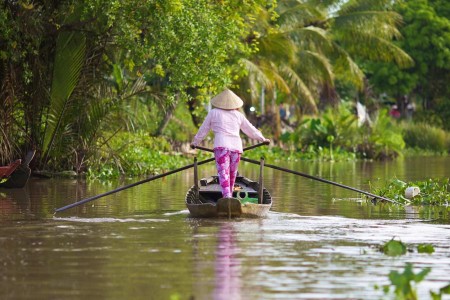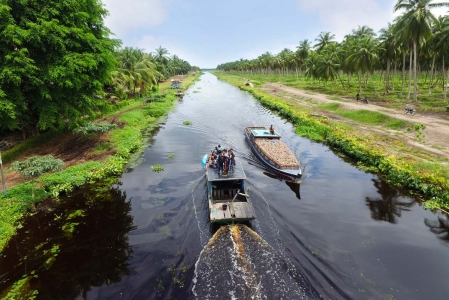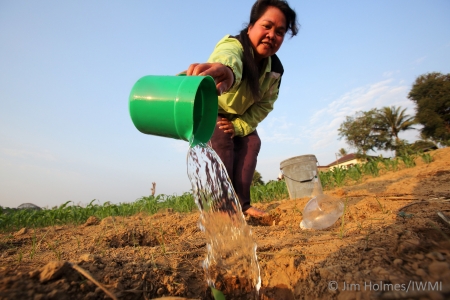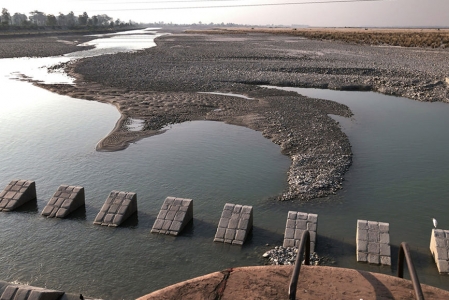On my ride to work every morning, I frequently get stuck at a stoplight, along with the other commuters of Vientiane, with no shelter from the sun – the black pavement, spewing exhaust pipes and reflective vehicles radiating heat around us. Little by little, dirt paths are replaced by these shiny roads, easing transport routes to and from Vientiane. Construction sites for roads, buildings and other infrastructure haphazardly dot the city, with asphalt and cement far more prevalent than green spaces.
At the 2015 Greater Mekong Forum on Water, Food and Energy, I attended a workshop hosted by the International Centre for Environmental Management (ICEM) on green infrastructure in cities and towns in the Greater Mekong Subregion.

Green infrastructure involves the greening of conventional infrastructure as well as expanding the networks of natural areas within towns. It involves changing the way urban infrastructure – such as roads, river banks and buildings – are designed and managed to be sustainable, cost effective, and resilient to climate change.
An awe-inspiring video asked practitioners in the room to ‘bring nature back’ and incorporate resilience into development. Panelists shared the various environmental benefits of bioengineering, including significantly lower costs and ease of use for local communities. I had Vientiane’s debilitating urban heat island effect in mind. Oh, what trees could do!
Resilience strategies from around the world
In the weeks since the forum, I reviewed ICEM’s Resilience Resource Kit and tried to glean its relevance for the Mekong. The basic principles of green infrastructure outlined in the Resilience Resource Kit draw on the expertise of cities and towns from different corners of the world such as the UK Town and County Planning Association.
At times, I found the lack of local context glaring. Green infrastructure strategies regularly refer to master planning, zoning schemes and development controls, processes that are not a given in Mekong towns. Comparisons to such cities as Portland, Oregon in the U.S.A. or Melbourne in Australia hardly resonate. Diagrams do not bear resemblance to the developing small and medium towns in the Mekong.

Yet, climate change often exposes the same vulnerabilities – sea level rise, storm surge, increased flooding and more extensive droughts – that threaten populations and infrastructure in all regions of the world.
In the three case studies conducted in Battambang, Cambodia, Dong Ha, Vietnam and Kaysone Pomvihane, Lao PDR, Climate Change Core Groups identified hot spots most prone to flooding and infrastructure damage and proposed a range of bio-engineering best practices such as stabilizing riverbanks and expanding tree canopy.
Town planning in the Mekong
Grey infrastructure drives the development of Mekong towns, with major programs proceeding on a project-by-project basis. Small and medium towns in the Mekong may not have spatial master plans; if they do, the revision of such plans is not systematic, and the impacts of climate change have not been considered. Not only does green infrastructure planning require knowledge about the effects of climate change, it also requires funding and capacity to strategically incorporate nature into infrastructure projects.
In the local context of the Mekong, how realistic is it to incorporate green infrastructure into city and town level planning? Indeed, ICEM’s Resilience Resource Kit provides an important toolkit of green infrastructure technologies available for cities and towns in the Mekong. But how do cities and towns build capacity for green infrastructure? And where do the funds for trees, river buffers and other green infrastructure measures come from? Can local communities influence the work of private developers?
The three case studies in the Mekong demonstrate the institutional and financial challenges of implementation. For example, there is no statutory obligation for Cambodian towns to regularly review and revise master plans. In Dong Ha, Vietnam, the town plan in fact encourages development in low lying and flood prone areas, and in Kaysone Phomvihane there is limited budget for maintenance of existing town infrastructure.
With limited systematic town planning in the Mekong, ICEM highlights the need for (1) green infrastructure demonstration sites and (2) capacity building for municipal and provincial officials in assessing vulnerability to climate change and deploying green infrastructure technologies.
While I don’t expect to be any cooler commuting on Vientiane’s bustling roads, ICEM’s Resilience Resource Kit does offer a step-by-step planning guide for addressing climate change threats and implementing green infrastructure solutions. With the engagement of the local community, government officials and infrastructure engineers – perhaps with a Climate Change Core Group – and a well-documented network of pilot projects, Vientiane would be heading in the right direction for bringing nature back to urban development.















Comments
There used to be lots of large trees in Vientiane, planted I understand, during the French rule, but around 2000 these were cut as part of road work funded by ADB. There was some community opposition but it had no effect. The timber was valuable and I guess had been priced into the construction bid.
Some years later, there was an attempt through development assistance to create a constructed wetland in the city. This faltered because of poor management of drainage water quality which resulted in strong bad odors and complaints from the public. I understand drainage was re-routed to the river.
Green infrastructure needs cross-disciplinary planning. A major impediment in Asian institutional arrangements is the structure of government agency responsibilities and the operation of the silo effect, preventing cooperation among agencies. The Ministry which might be appropriate to drive such planning and management, Natural Resources and Environment, does not have the political power to influence those responsible for urban planning and construction.
Thanks for reading, Hugh, and for a very knowledgeable comment. Any idea where I could get more information about either project? I’m curious to learn more about various waves of green infrastructure in Vientiane.
I think the silo effect among government agencies is a global phenomenon!
Have a search on ADB, World Bank and bilateral development (eg Agence Française de Développement) websites. Look at https://www.adb.org/documents/lao-peoples-democratic-republic-vientiane-...